A New Data-Stream-Mining-Based Battery Equalization Method
Abstract
:1. Introduction
2. Related Work
2.1. Data Stream Mining and Concept Drift
2.2. Single Switched Capacitor (SSC) Topology
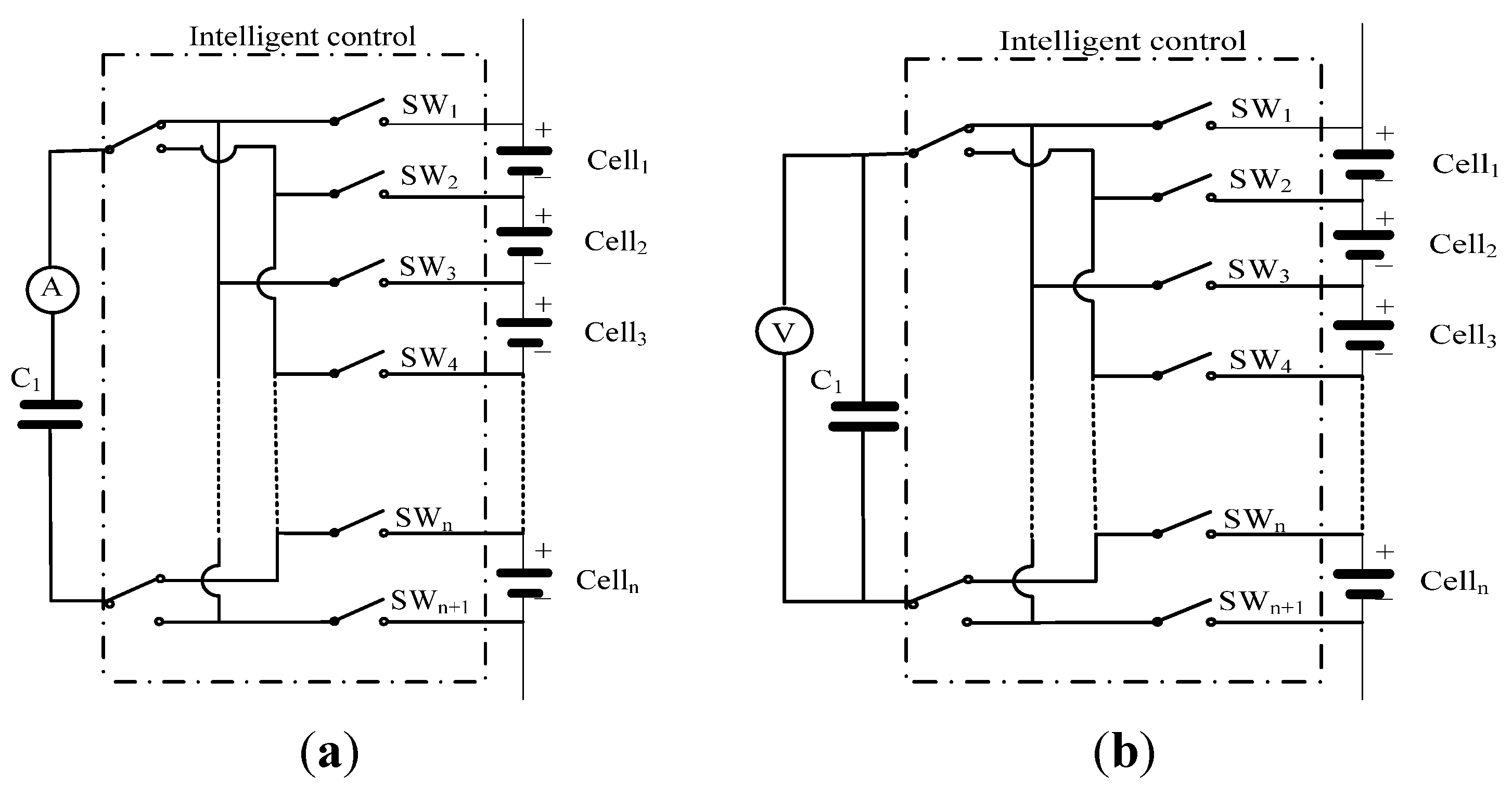
3. Data-Stream-Mining Based Battery Equalization Method
3.1. Extracting Summary Information
| Algorithm |
| (1) Initializing DS. Clean the records in it. |
| (2) Recording data. Every times the current sensor inputs a new record for celln, we first lookup DS to see whether or not an entry for it has exist. If finds, update the entry by incrementing the shuttling electric charge quantity of celln, Qn(t). Otherwise, creates a new entry (n, Qn) for it. |
| (3) Does a window boundary arrives? Yes, go (4); No, go (2). |
| (4) Moving the DS to a special memory DS* (DS* was used for directing the balancing processes in the proposed control strategy, we can see this in Section 3.2); go (1). |
Examples
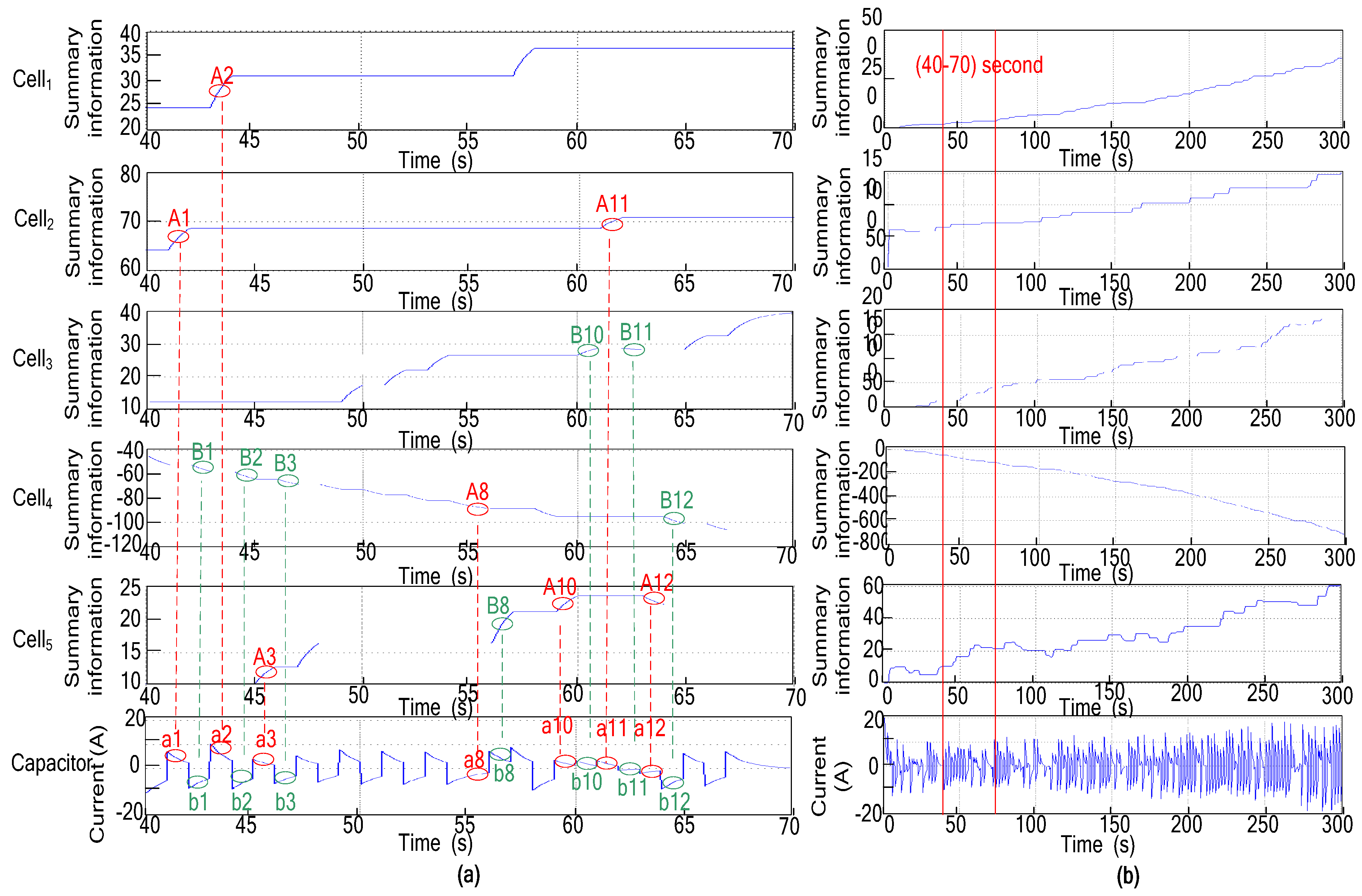
3.2. The Proposed Balancing Strategy
- (1)
- Data acquiring: Reads in the summary information from DS*, ranks the entry (n, Qn) with the values of Qn.
- (2)
- Voltage monitoring: Check the terminal voltages of cells. If the terminate voltage, Vn, of a cell, celln, reaches the end-of-charge/end-of-discharge voltage threshold, Vhigh/Vlow, closes the charge/discharge process. Begins a new window and go to (1). Otherwise, go to (3).
- (3)
- Period D1: Searches an entry (n, Qn) in DS*, the value Qn of which is the largest one; closes the two neighboring switchers of celln and shuttles the charges from celln to capacitor C1; updates the shuttling electric charge quantity, Qn (Qn = Qn − Q′). Q′ is the shuttled electric charge quantity in period D1.
- (4)
- Period D2: Searches an entry (m, Qm) in DS*, the value Qm of which is the lowest one; closes the two neighboring switchers of cellm and shuttles the charges from capacitor C1 to cellm; updates the shuttling electric quantity, Qm (Qm = Qm + Q″). Q″ is the shuttled electric quantity in period D2.
- (5)
- Shutting electric charge quantity checking: If all of the Qi in DS* meet the conditions of “|Qi| ≤ Δ”, go to (6). Otherwise, go to (2) (Δ is a capacity-updating parameter).
- (6)
- Balancing the cells with a traditional voltage-based strategy.
- (7)
- Checking the window boundaries: Does a window boundary arrive? Yes, delete the entries (n, Qn) in DS*, reads in new entries from DS and go to (1). No, go to (6).
3.3. Strategy Analysis
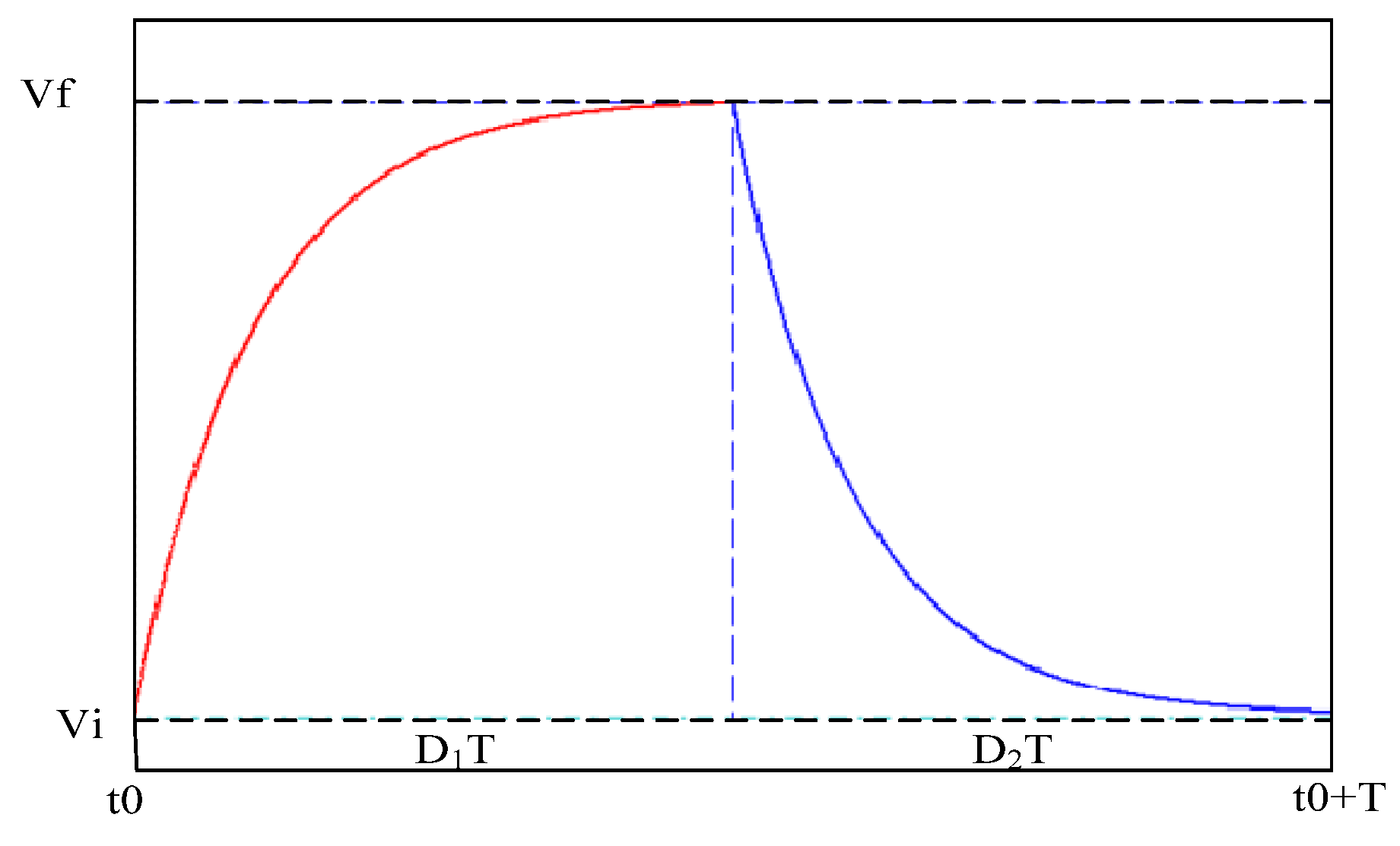
- (1)
- For lithium-based batteries, the OCV-SOC characteristic curves (charge/discharge) in the area of 10%–90% is a flat and linear one. So, we can approximately express the OCV like this,
- (2)
- However, for two different cells, cellj and cellk, if at time t, one OCV-SOC characteristic curve of them keeps in the area of 10%–90% and the other OCV-SOC characteristic curve goes into the area of 0%–10%, then, with the increase of time t, the voltage difference between them will enlarge quickly. It can be seen in Figure 2, where in the green area, the voltage difference between cell4 and cell1 is very large. In this condition, the shuttling efficiency of the current increases with time. With the same probability distribution of the noises, the larger the voltage difference between cells become, the less the probability for mistakenly selecting the cells to shuttle current will be.

3.4. Validity Analysis
- (1)
- Each adjacent window, Windowj−1 and Windowj, has the same number of D1/D2 periods (ND1 = ND2).
- (2)
- In every half cycle, D1, if we properly select cells to shuttle current, all of the shuttling currents of them have the same value QT′. If we wrongly select cells to shuttle current, all of the shuttling currents of them have the same value QF′.
- (3)
- In every half cycle, D2, if we properly select cells to shuttle current, all of the shuttling currents of them have the same value QT*. If we wrongly select cells to shuttle current, all of the shuttling currents of them have the same value QF*.
- (4)
- In each window, the probability of rightly selecting celli in D1 is p(i,T) and the probability of wrongly selecting Celli in D1 is p(i,F).
- (5)
- In each window, the probability of rightly selecting cellm in D2 is p(m,T) and the probability of wrongly selecting Cellm in D1 is p(m,F).
4. Simulations
4.1. The Influences of Noise
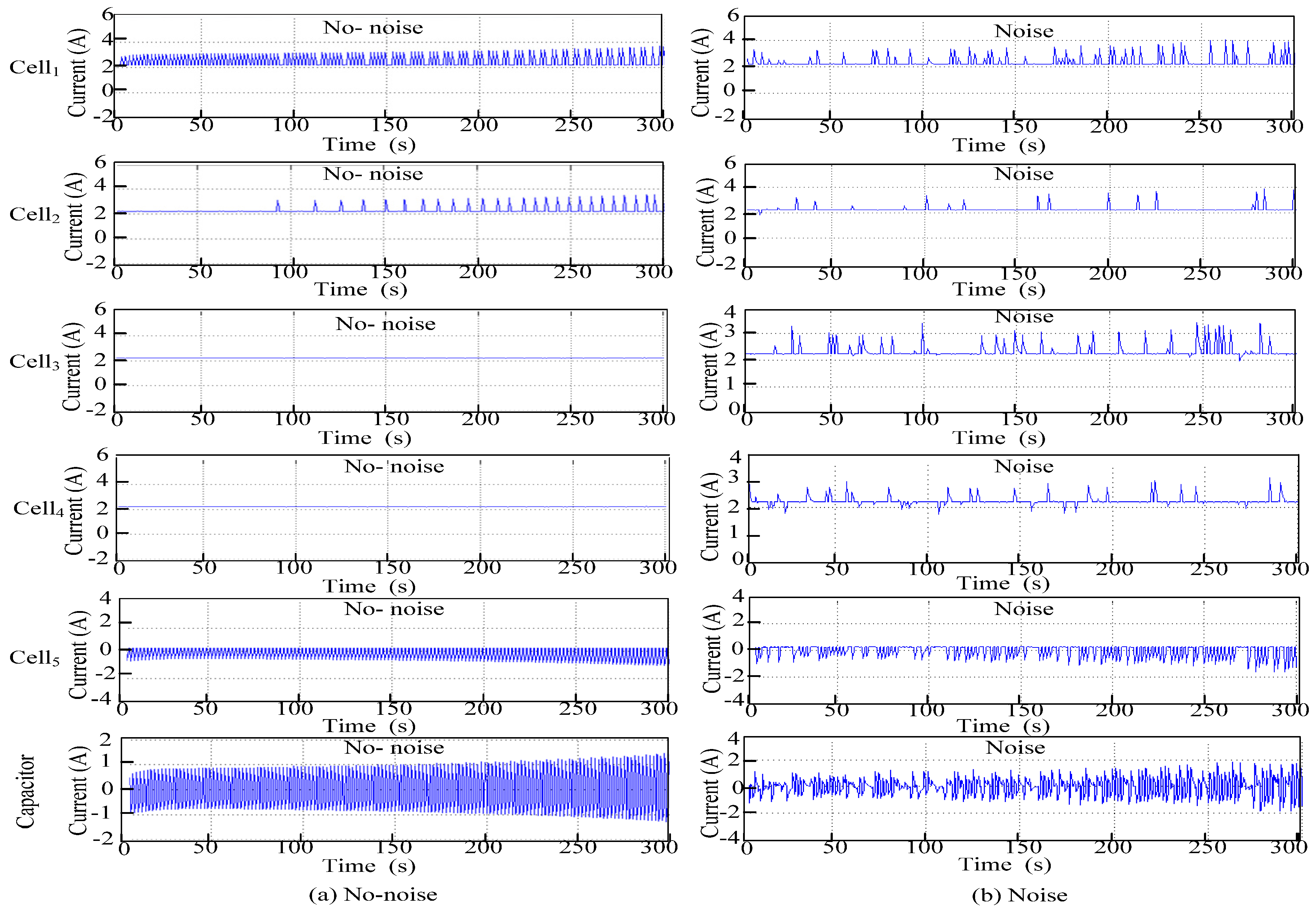
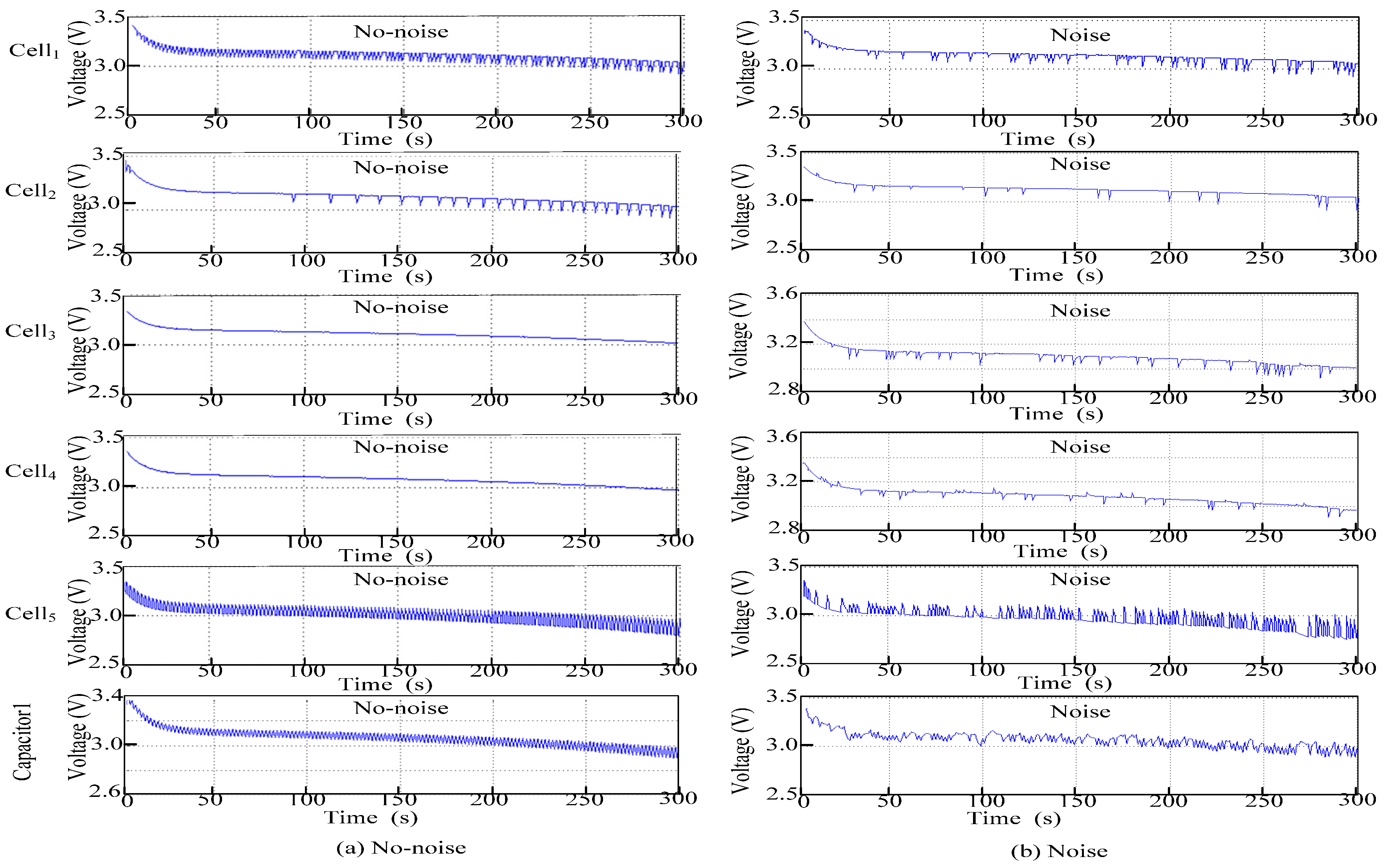
4.2. Extracting the Summary Information in Noise or No-Noise Conditions
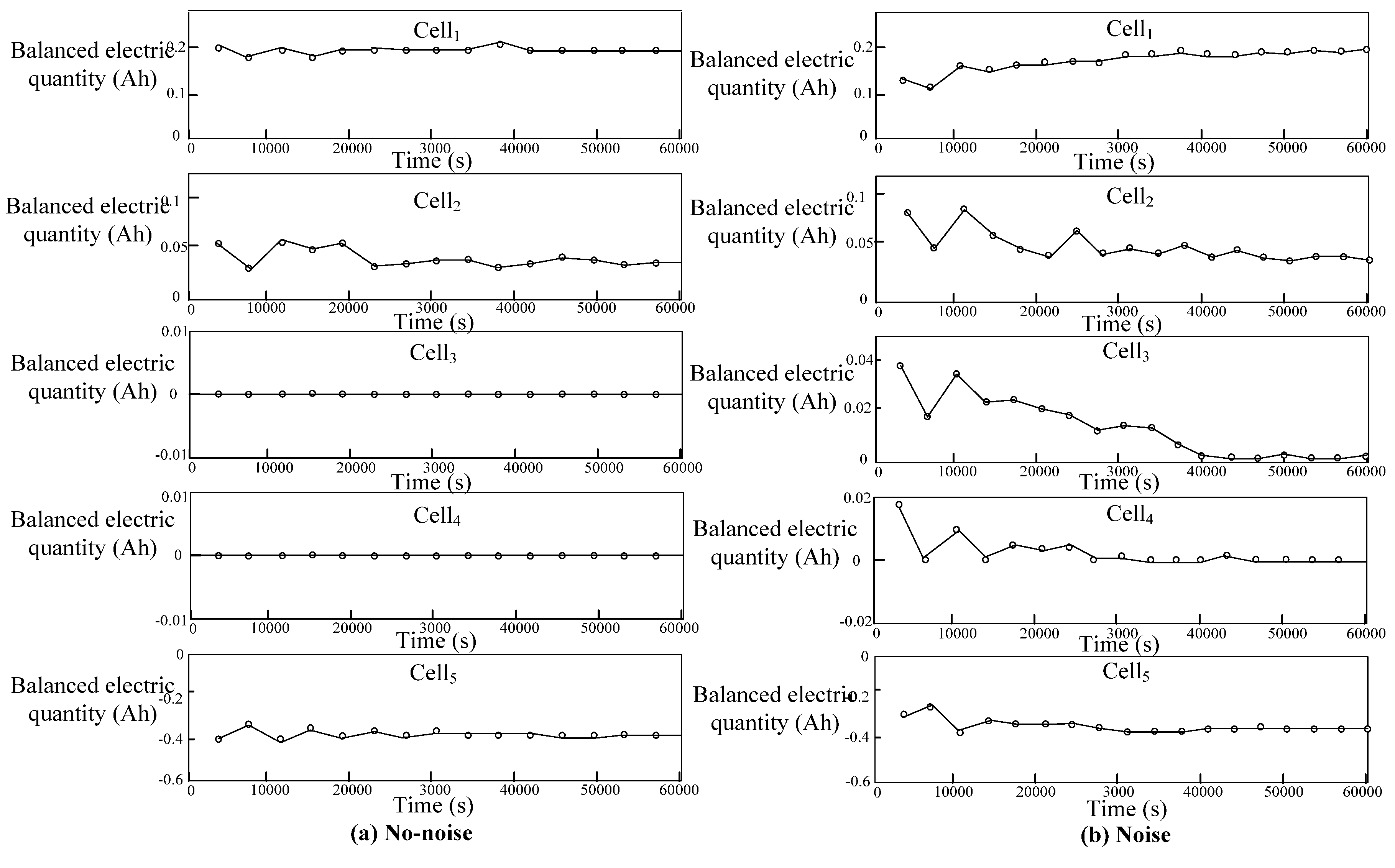
4.3. Working without Terminal Voltage Comparison
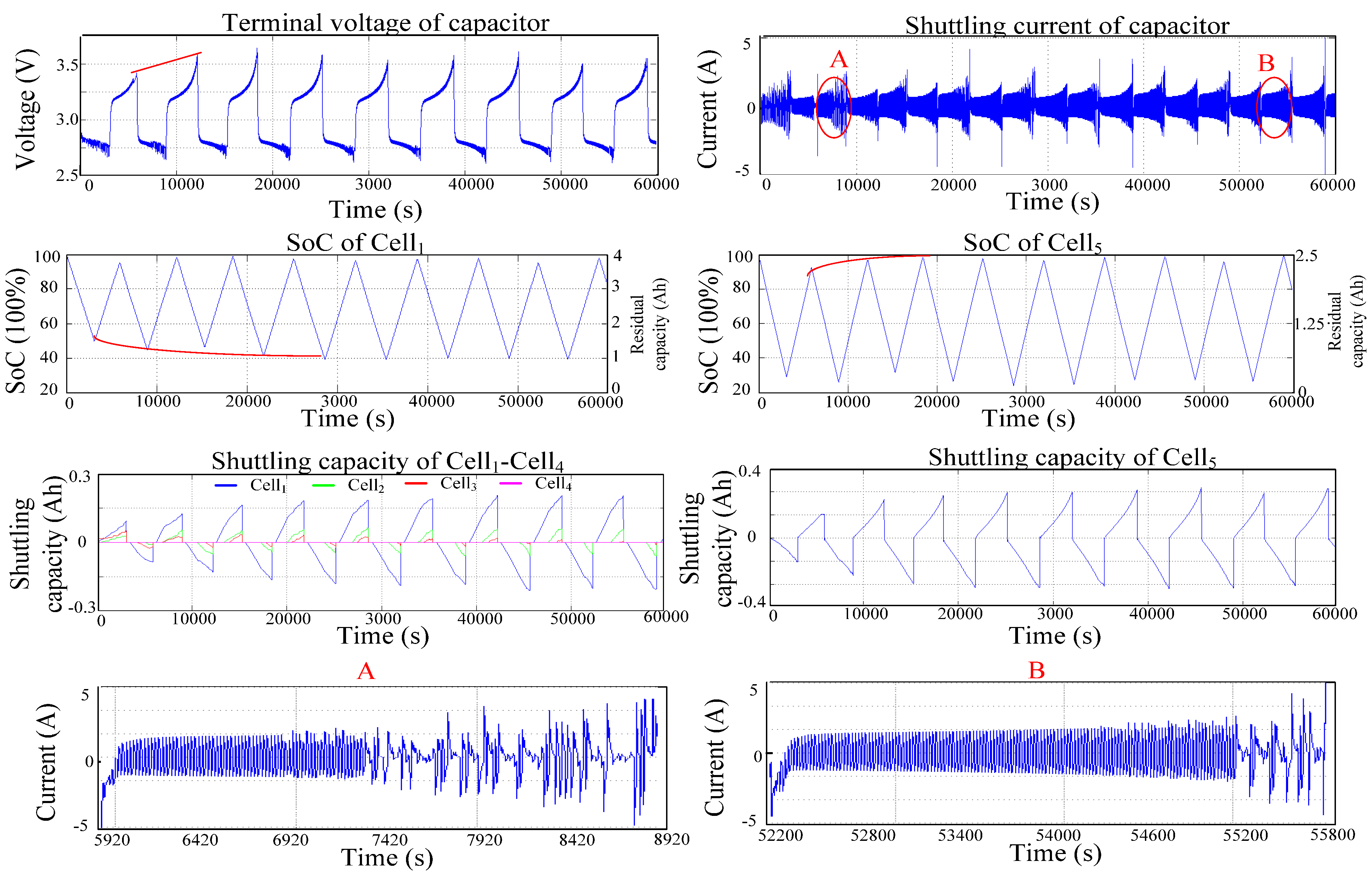
4.4. Dealing with Concept Drifts


5. Experiments
5.1. Experimental Environment

5.2. Discharging Characteristic Curves of the Cells
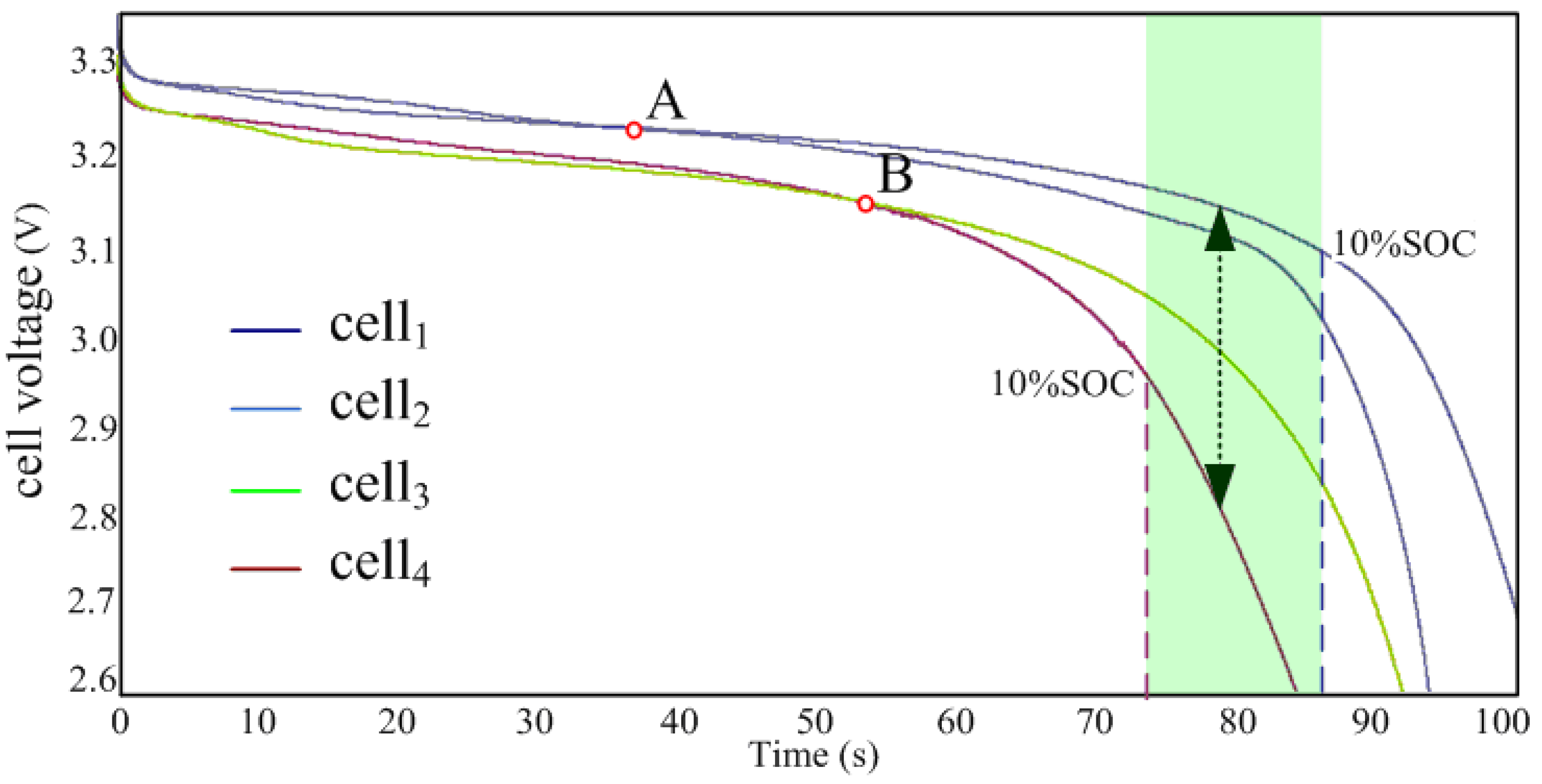
5.3. Strategy Comparison
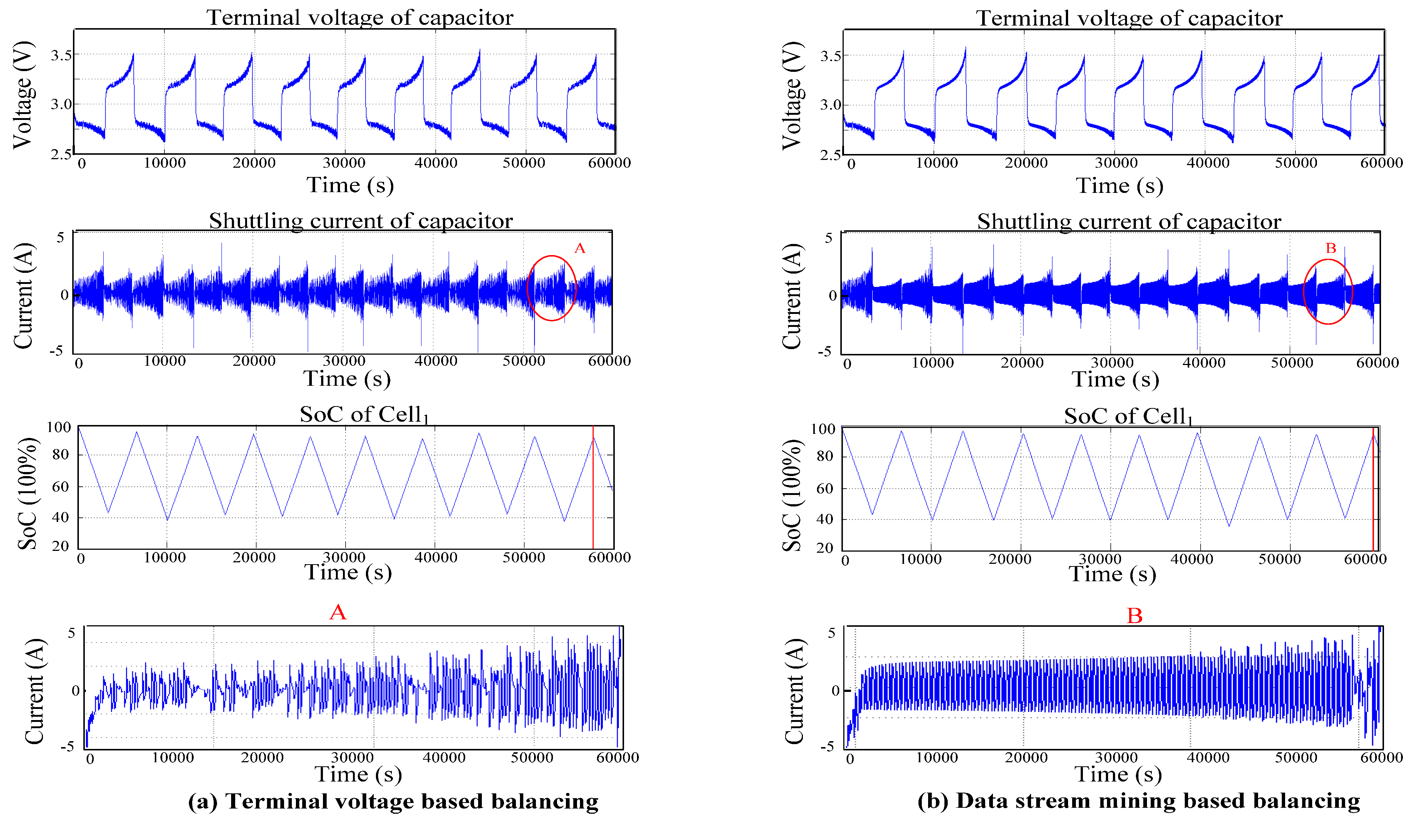
6. Cost and Computational Time Analysis
7. Conclusions
- (1)
- The balancing strategy can effectively deal with concept-drifts of cells (the rated capacity changes with time) and automatically adjust the balance process to fit it.
- (2)
- The proposed algorithm has the capability of balancing the individual cells in noise conditions and can deal with the inconsistencies of cells.
- (3)
- Data stream mining technique was integrated into the balancing process and the historical information was used to direct the balancing process. The algorithm can not only balance the cell’s residual capacities online, but can also report the their health state indirectly.
Acknowledgments
Author Contributions
Conflicts of Interest
References
- Lu, L.; Han, X.; Li, J. A review on the key issues for lithium-ion battery management in electric vehicles. J. Power Sources 2013, 226, 272–288. [Google Scholar] [CrossRef]
- Daowd, M.; Omar, N.; van den Bossche, P.; van Mierlo, J. Extended PNGV battery model for electric and hybrid vehicles. J. Int. Rev. Electr. Eng. 2011, 6, 1264–1278. [Google Scholar]
- Scrosati, B.; Garche, J. Lithium batteries: Status, prospects and future. J. Power Sources 2010, 195, 2419–2430. [Google Scholar] [CrossRef]
- Lee, Y.-S.; Cheng, M. Intelligent Control Battery Equalization for Series Connected Lithium-Ion Battery Strings. IEEE Trans. Ind. Electron. 2005, 52, 1297–1307. [Google Scholar] [CrossRef]
- Broussely, M.; Biensasn, P.; Bonhomme, F. Main aging mechanisms in Li ion batteries. J. Power Sources 2005, 146, 90–96. [Google Scholar] [CrossRef]
- Zheng, Y.; Ouyang, M.; Lu, L.; Li, J.; Han, H.; Xu, L. On-line equalization for lithium-ion battery packs based on charging cell voltages: Part 1. Equalization based on remaining charging capacity estimation. J. Power Sources 2014, 247, 676–686. [Google Scholar] [CrossRef]
- Zheng, Y.; Lu, L.; Han, X. LiFePO4 battery pack capacity estimation for electric vehicles based on charging cell voltage curve transformation. J. Power Sources 2013, 226, 33–41. [Google Scholar] [CrossRef]
- Zheng, Y.; Han, X.; Lu, L.; Li, J.; Ouyang, M. Lithium ion battery pack power fade fault identification based on Shannon entropy in electric vehicles. J. Power Sources 2013, 223, 136–146. [Google Scholar] [CrossRef]
- Hurley, W.G.; Wong, Y.S.; Wölfle, W.H. Self-Equalization of Cell Voltages to Prolong the Life of VRLA Batteries in Standby Applications. IEEE Trans. Ind. Electron. 2009, 56, 2115–2120. [Google Scholar] [CrossRef]
- Daowd, M.; Omar, N.; van den Bossche, P.; van Mierlo, J. A review of passive and active battery balancing based on MATLAB/Simulink. J. Int. Rev. Electr. Eng. 2011, 6, 2974–2989. [Google Scholar]
- Manenti, A.; Abba, A.; Merati, A.; Savaresi, S.; Geraci, A. A New BMS Architecture Based on Cell Redundancy. IEEE Trans. Ind. Electron. 2011, 58, 4314–4322. [Google Scholar] [CrossRef]
- Teofilo, V.L.; Merritt, L.V.; Hollandsworth, R.P. Advanced lithium-ion battery charger. IEEE Aerosp. Electron. Syst. Mag. 1997, 12, 30–36. [Google Scholar] [CrossRef]
- Lin, C.H.; Wang, C.M.; Chao, H.Y.; Hung, M.H. Dual-balancing control for improving imbalance phenomenon of lithium-ion battery packs. In Proceedings of the IEEE Third International Conference on Sustainable Energy Technologies (ICSET), Kathmandu, Nepal, 24–27 September 2012; pp. 229–234.
- Lee, Y.S.; Cheng, G.T. Quasi-Resonant Zero-Current-Switching Bidirectional Converter for Battery Equalization Applications. IEEE Trans. Power Electron. 2006, 21, 1213–1224. [Google Scholar] [CrossRef]
- Moo, C.S.; Hsieh, Y.C.; Tsai, I.S. Charge equalization for series-connected batteries. IEEE Trans. Aerosp. Electron. Syst. 2003, 39, 704–710. [Google Scholar] [CrossRef]
- Imtiaz, A.M.; Khan, F.H. “Time shared flyback converter” based regenerative cell balancing technique for series connected Li-ion battery strings. IEEE Trans. Power Electron. 2013, 28, 5960–5975. [Google Scholar] [CrossRef]
- Young, C.M.; Chu, N.Y.; Chen, L.R.; Hsiao, Y.-C.; Li, C.-Z. A single phase multilevel inverter with battery balancing. IEEE Trans. Ind. Electron. 2013, 60, 1972–1978. [Google Scholar] [CrossRef]
- Maharjan, L.; Inoue, S.; Akagi, H.; Asakura, J. State-of-Charge (SOC)-Balancing Control of a Battery Energy Storage System Based on a Cascade PWM Converter. IEEE Trans. Power Electron. 2009, 24, 1628–1636. [Google Scholar] [CrossRef]
- Uno, M.; Tanaka, K. Single-Switch Multi-Output Charger Using Voltage Multiplier for Series-Connected Lithium-Ion Battery/Supercapacitor Equalization. IEEE Trans. Ind. Electron. 2013, 60, 3227–3239. [Google Scholar] [CrossRef]
- Ugle, R.; Li, Y.; Dhingra, A. Equalization integrated online monitoring of health map and worthiness of replacement for battery pack of electric vehicles. J. Power Sources 2013, 223, 293–305. [Google Scholar] [CrossRef]
- Xu, A.; Xie, S.; Liu, X. Dynamic Voltage Equalization for Series-Connected Ultra-capacitors in EV/HEV Applications. IEEE Trans. Veh. Technol. 2009, 58, 3981–3987. [Google Scholar]
- Chen, W.-L.; Cheng, S.-R. Optimal charge equalization control for series-connected batteries. IET Gener. Transm. Distrib. 2013, 7, 843–854. [Google Scholar] [CrossRef]
- Park, H.S.; Kim, C.H.; Park, K.B.; Moon, G.W.; Lee, J.H. Design of a charge equalizer based on battery modularization. IEEE Trans. Veh. Technol. 2009, 58, 3216–3223. [Google Scholar] [CrossRef]
- Nasraoui, O.; Rojas, C.; Cardona, C. A Framework for Mining Evolving Trends in Web Data Streams using Dynamic Learning and Retrospective Validation. J. Comput. Netw. 2006, 50, 1425–1652. [Google Scholar] [CrossRef]
- Widmer, G. Tracking Context Changes through Meta-Learning. Mach. Learn. 1997, 27, 256–286. [Google Scholar] [CrossRef]
- Minku, L.L.; Yao, X. DDD: A New Ensemble Approach for Dealing with Concept Drift. IEEE Trans. Knowl. Data Eng. 2012, 24, 619–633. [Google Scholar] [CrossRef]
- Minku, L.L.; White, A.P.; Yao, X. The Impact of Diversity on On-Line Ensemble Learning in the Presence of Concept Drift. IEEE Trans. Knowl. Data Eng. 2010, 22, 730–742. [Google Scholar] [CrossRef]
- Scholz, M.; Klinkenberg, R. Boosting Classifiers for Drifting Concepts. In Intelligent Data Analysis (IDA); IOS Press: Amsterdam, The Netherlands, 2007; Volume 11, pp. 3–28. [Google Scholar]
- Baughman, A.C.; Ferdowsi, M. Double-tiered switched-capacitor battery charge equalization technique. IEEE Trans. Ind. Electron. 2008, 55, 2277–2285. [Google Scholar] [CrossRef]
- Kimball, J.W.; Krein, P.T. Analysis and Design of Switched Capacitor Converters. In Proceedings of the Twentieth Annual IEEE Applied Power Electronics Conference and Exposition (APEC’05), Austin, TX, USA, 6–10 March 2005; Volume 1473, pp. 1473–1477.
- Ben-Yaakov, S.; Evzelman, M. Generic and unified model of Switched Capacitor Converters. In Proceedings of the IEEE Energy Conversion Congress and Exposition (ECCE’09), San Jose, CA, USA, 20–24 September 2009; pp. 3501–3508.
- Daowd, M.; Antoine, M.; Omar, N.; Lataire, P.; van den Bossche, P.; van Mierlo, J. Battery Management System-Balancing Modularization Based on a Single Switched Capacitor and Bi-Directional DC/DC Converter with the Auxiliary Battery. Energies 2014, 7, 2897–2937. [Google Scholar] [CrossRef]
- Gallardo-Lozano, J.; Romero-Cadaval, E.; Milanes-Montero, M.I.; Guerrero-Martinez, M.A. Battery equalization active methods. J. Power Sources 2014, 246, 934–949. [Google Scholar] [CrossRef]
© 2015 by the authors; licensee MDPI, Basel, Switzerland. This article is an open access article distributed under the terms and conditions of the Creative Commons Attribution license (http://creativecommons.org/licenses/by/4.0/).
Share and Cite
Lin, C.; Mu, H.; Zhao, L.; Cao, W. A New Data-Stream-Mining-Based Battery Equalization Method. Energies 2015, 8, 6543-6565. https://doi.org/10.3390/en8076543
Lin C, Mu H, Zhao L, Cao W. A New Data-Stream-Mining-Based Battery Equalization Method. Energies. 2015; 8(7):6543-6565. https://doi.org/10.3390/en8076543
Chicago/Turabian StyleLin, Cheng, Hao Mu, Li Zhao, and Wanke Cao. 2015. "A New Data-Stream-Mining-Based Battery Equalization Method" Energies 8, no. 7: 6543-6565. https://doi.org/10.3390/en8076543




